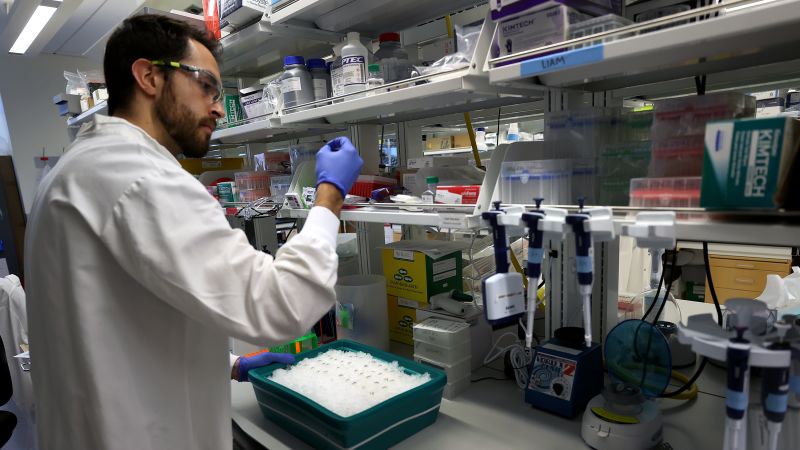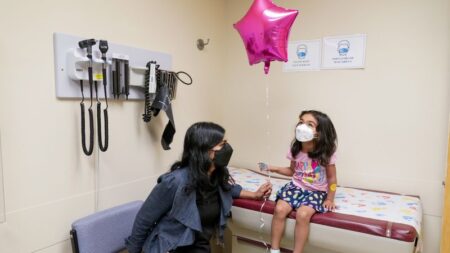Headline: Rising Concerns Over H5N1 Bird Flu Virus as Fall Approaches in the U.S.
As the fall season approaches and cooler temperatures set in across the United States, health officials are warning that the H5N1 bird flu virus poses an increased risk. Steps are being taken to prevent the formation of a hybrid flu virus that could potentially infect humans more easily.
Experts indicate that the fall and winter months are prime times for the H5N1 virus to spread and mutate due to increased movement among cattle and other flu viruses. While current human infections have generally been mild, health officials note that each new case presents an opportunity for the virus to enhance its ability to infect humans.
“To be clear, we have no evidence so far that this virus can easily infect human beings or that it can spread between human beings easily in a sustained fashion,” stated Dr. Jennifer Nuzzo, director of the Pandemic Center at Brown University’s School of Public Health. “If it did have those abilities, we would be in a pandemic.”
At a recent seminar hosted by the Health Coverage Fellowship, Nuzzo added, “The second we know that someone gave it to someone else relatively easily, that’s a new pandemic, and it will be around the globe, probably in a matter of weeks.”
This cautionary note comes as scientists investigate a puzzling case in Missouri where an individual with no direct contact with animals contracted a type of bird flu. According to Dr. Nirav Shah, principal deputy director of the Centers for Disease Control and Prevention (CDC), the person had “significant underlying health conditions” making them more susceptible to the infection.
The patient tested positive for the flu after hospitalization on August 22, received antiviral treatment, and has since recovered. Further testing by the Missouri State Public Health Laboratory confirmed an H5 flu subtype, an uncommon variant with only 13 such infections reported in humans across the U.S. this year. The majority of these cases involve farm workers with direct exposure to infected birds or cows.
The CDC is actively working to sequence the virus genome from the Missouri case to determine its relation to strains affecting poultry and dairy cattle. However, due to limited viral material in the patient’s samples, complete sequencing may prove challenging.
“The data that we do have and that have been generated thus far show an H5 virus that is closely related to the H5 virus circulating among dairy cows,” Dr. Shah noted.
Investigators are following up with the patient and tracing recent contacts. There are currently no indications that the virus has been transmitted to others in the vicinity, and there is no unusual flu activity reported in the area.
“Seeing that someone is in the hospital with possible H5N1 heightens my worry,” Nuzzo expressed. “It not only heightens my worry for the farm workers, who are most at risk from infection, but it also heightens the worry that we’re allowing this virus to gain new abilities.”
The emergence of H5N1 in U.S. dairy cattle took many by surprise earlier this year, with reports indicating that new cases have slowed during the summer months when dairy cows are less active due to heat and decreased milk demand. However, the situation is expected to change as fall approaches, necessitating the movement of cattle to graze on harvested fields.
“Greater movement of cattle could give the H5N1 virus more opportunities to spread,” Deeble warned.
In a proactive move, the USDA has mandated testing of dairy cows before they can travel across state lines, though such requirements do not extend to internal movements within the same state. Moreover, this order does not necessitate testing every animal within large groups, raising concerns over asymptomatic infected cows potentially being moved undetected.
These concerns have intensified following recent findings that three dairy herds in California’s Central Valley tested positive for H5N1, with infected herds in the state increasing to eight as of September 12. California, home to approximately 1.7 million dairy cows, accounts for around one-sixth of the national total.
The route through which the virus entered California remains under investigation, but genetic tests suggest a close relation to viruses impacting over 200 herds in 13 other states.
Since the initial confirmations of H5N1 in herds in Texas and Kansas in March, evolutionary biologists believe the infection likely spread among cattle months prior, possibly taking hold with the aid of migrating birds.
The genetic similarities between the viruses infecting California herds and the initial cases are significant, indicating that infections were likely spread from cow to cow as opposed to another introduction from migrating birds. “So we were dealing essentially with one variant from the very beginning of this outbreak,” Deeble said.
Wastewater testing has consistently indicated the presence of H5 viruses in California since March, with state monitoring revealing that California is one of nine states where such viruses have been detected.
The seasonal movement of animals raises the stakes as flu viruses begin to circulate more widely in the U.S., thereby increasing the potential for farmworkers to become co-infected with both bird flu and seasonal flu.
Experts note that reassortment—where two flu viruses swap genetic material—could lead to the emergence of a new virus with enhanced properties, a phenomenon that has been observed in past pandemics. While the CDC has recommended annual flu vaccinations for everyone over six months old, uptake remains low, with less than half of all adults and children vaccinated last year.
The agency is emphasizing the importance of flu vaccines, particularly for those directly working with farm animals, as a key measure to prevent reassortment events this year.
With plans underway to conduct intensive outreach and educate farmworkers about vaccination options, the CDC aims to roll out these efforts beginning in October. However, increasing vaccination rates among farmworkers may present challenges due to various factors, including the need for health and safety training within the agricultural sector.
Alcauter’s organization, which received about $4 million from the CDC for these initiatives, is seeking partnerships with community groups to drive awareness and support vaccination efforts among farmworkers.
Although there is a reasonable level of acceptance of vaccines among many farmworkers, advocates caution that traditional flu vaccines do not confer protection against H5N1 viruses originating from poultry or cattle.
Despite having nearly 5 million doses of H5N1 vaccine prepared for potential deployment, there are currently no plans to administer these doses, including to farmworkers identified as at higher risk. In contrast, Finland has chosen to vaccinate its farmworkers against H5N1 after facing similar outbreaks.
Experts like Dr. Adam Kucharski point out that pandemic-causing viruses typically develop in stages, and timely intervention during early spillover cases can greatly enhance the effectiveness of prevention measures. As concerns over H5N1 surveillance and response grow, Kucharski stresses the need for the U.S. to adopt more proactive approaches to testing and monitoring to avert possible spread.
While the CDC currently assesses the threat from H5N1 as low, federal agencies are preparing to respond should infections increase in frequency or severity. In a recent funding allocation, the CDC announced a $5 million investment to labs tasked with developing tests for H5 viruses, hoping to improve readiness for potential outbreaks.
Dr. Shah remarked on the agency’s efforts to integrate commercial labs into the testing development process alongside public health initiatives, aiming to enhance overall response efficacy.












